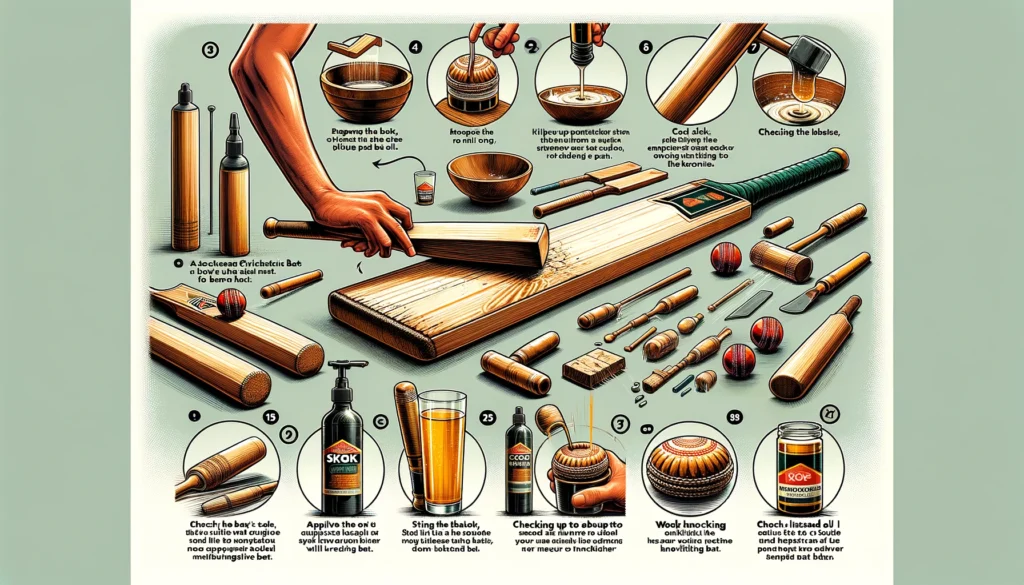How to Increase the Stroke of Your Cricket Bat?
Are you a passionate cricket enthusiast seeking to enhance your batting performance? Look no further! In this comprehensive guide, we’ll explain how to increase the stroke of your cricket bat, explaining its full potential and taking your game to new heights.
WHERESTHEMATCH – Watch Today Live Matches
Time Zone: GMT +00:00 Europe/London
Whether you’re an aspiring cricketer or a seasoned veteran, this article about ‘How to Increase the Stroke of Your Cricket Bat?’ is a must-read if you want to maximize your batting prowess and leave a lasting impression on the pitch.
Key Takeaways
- Proper preparation enhances both bat stroke and lifespan.
- Choose raw linseed oil for optimal bat conditioning.
- Follow a systematic knocking-in process for the best results.
- Regular maintenance ensures your bat remains in top condition.
- Avoid common preparation mistakes for lasting performance.
The Science Behind Knocking: How it Improves Bat Stroke
Before we go into the step-by-step process of how to increase the stroke of your cricket bat, it’s essential to understand the science behind knocking and how it enhances a cricket bat’s stroke.
Knocking, or knocking-in, is the act of repeatedly striking the face and edges of the bat with a specialized mallet or hardwood block.
This process of How to increase the stroke of your cricket bat compresses and densifies the willow fibers, creating a harder and more responsive striking surface.

The compression caused by knocking leads to several benefits:
- Improved Power Transfer: A well-knocked bat can transfer more energy from the bat’s swing to the cricket ball, resulting in increased ball speed and longer hitting distances.
- Enhanced Sweet Spot: The “sweet spot” on the bat’s face, where the ball makes optimal contact, becomes larger and more forgiving after knocking.
- Increased Durability: The compressed willow fibers become more resilient, reducing the risk of cracks, dents, or premature deterioration of the bat’s surface.
- Better Ball Control: A properly knocked bat provides a more consistent and predictable response when striking the ball, allowing batters to better control the direction and trajectory of their shots.
By understanding the science behind knocking, you’ll appreciate the importance of this process of how to increase the stroke of your cricket bat and be motivated to follow the steps carefully to achieve optimal results.
How to Increase the Stroke of Your Cricket Bat?: A Step-by-Step Guide

How to increase the stroke of your cricket bat is a meticulous process that requires patience and attention to detail. Follow these steps to maximize your bat’s performance:
Step 1: Prepare the Bat Surface
Start by ensuring your cricket bat’s surface is clean and free of any debris or residue. Use a soft cloth to gently wipe down the face and edges of the bat.
Step 2: Apply Bat Oil
Using raw linseed oil or a specialized cricket bat oil, apply a thin, even coat onto the face and edges of the bat. Avoid over-oiling, as too much can be counterproductive.
Recommended Bat Oils
Here are some high-quality bat oils recommended by cricket experts:
| Bat Oil | Description |
|---|---|
| Raw Linseed Oil | A natural oil that deeply nourishes and conditions willow fibers. |
| Gray-Nicolls Bat Oil | A specialized oil designed specifically for cricket bats. |
| Kookaburra Bat Oil | A popular choice among professional cricketers, known for its superior conditioning properties. |
| Gunn & Moore Bat Oil | An oil that enhances the bat’s performance while providing long-lasting protection. |
Step 3: Let the Oil Absorb
Allow the oil to fully absorb into the willow wood for at least 24 hours. This process helps condition and strengthen the bat’s fibers, preparing it for the knocking process.
Step 4: Set Up a Knocking Station
Use a sturdy table or a dedicated knocking machine to secure your bat during the knocking process. Ensure the surface is flat and stable to prevent any unwanted movements or vibrations.
Step 5: Start Knocking
Using a specialized bat mallet or a hardwood block, begin knocking the face and edges of the bat in a systematic pattern. Start with lighter strikes and gradually increase the force as the bat becomes more compressed.
Knocking Technique
Follow this knocking pattern for optimal results:
- Start at the toe of the bat and work your way towards the splice (handle).
- Knock the face of the bat first, then move to the edges.
- Rotate the bat regularly to ensure even knocking across the entire surface.
- Increase the force of your strikes gradually, but avoid excessive force that could damage the bat.
Step 6: Check for Indentations
Inspect the bat’s surface for indentations or compressed areas, indicating that the knocking process is working. These indentations will help improve the bat’s stroke and power transfer when hitting the cricket ball.
Step 7: Maintain and Repeat
After the initial knocking session, continue to maintain the bat’s stroke by regularly applying a light coat of oil and knocking it periodically, especially before important matches or practice sessions.
Knocking Duration and Frequency
While the knocking duration can vary, most experts recommend knocking your bat for several hours, taking breaks as needed. As a general guideline:
- For new bats: Knock for around 6 hours, divided into multiple sessions.
- For regular maintenance: Knock for 1-2 hours before important matches or after extended use.
By following these steps diligently, you’ll be well on your way to achieving a cricket bat with an improved stroke, allowing you to unleash powerful shots and dominate the field.
The Importance of Using an English Willow Cricket Bat

When it comes to achieving an optimal stroke and performance, the choice of cricket bat material is paramount. English willow bats, crafted from the precious willow trees of Kashmir, are widely regarded as the gold standard in the cricket world.
English willow bats offer several advantages over other materials:
- Exceptional Power Transfer: The dense yet flexible nature of English willow allows for efficient energy transfer from the bat to the ball, resulting in powerful and long-distance shots.
- Durability and Longevity: English willow bats are known for their exceptional durability, able to withstand the rigors of intense matches and practice sessions while maintaining their performance over time.
- Consistent Performance: The uniform grain structure of English willow ensures a consistent and predictable response when striking the ball, enabling batters to develop a reliable stroke and timing.
- Prestige and Tradition: English willow bats have been the choice of cricket legends for generations, carrying a rich heritage and tradition that adds to the allure of owning and using one.
While English willow bats may come with a higher price tag than other options, their superior quality, performance, and longevity make them a worthwhile investment for serious cricketers seeking to elevate their game.
Choosing the Right Knocking Machine for Your Cricket Bat
While knocking your cricket bat by hand is a tried-and-true method, investing in a dedicated knocking machine can significantly streamline the process and ensure consistent results.
These specialized machines are designed to provide controlled, even strikes across the bat’s surface, reducing the risk of uneven compression or potential user error.
When choosing a knocking machine for your cricket bat, consider the following factors:
- Adjustable Strike Force: Look for a machine that offers adjustable strike force settings, allowing you to control the intensity of the knocking process. This is crucial for gradually increasing the compression without risking damage to your bat.
- Automated Rotation: Knocking machines with automated rotation features ensure that the strikes are evenly distributed across the bat’s face and edges, eliminating the need for manual rotation and reducing the risk of missed spots.
- Durability and Stability: A well-built knocking machine should be sturdy and stable, capable of withstanding the repetitive impacts without wobbling or shifting during operation.
- User-Friendly Controls: Opt for a machine with intuitive controls and clear instructions, making it easy to adjust settings and operate the device without confusion or guesswork.
- Portability and Storage: If you plan to use the knocking machine at different locations or have limited storage space, consider models that are compact and easily transportable or disassembled for convenient storage.
While knocking machines can represent a significant investment, they offer numerous benefits for serious cricketers and cricket enthusiasts looking to maximize their bat’s performance.
With a high-quality knocking machine, you can ensure consistent, even knocking, save time and effort, and achieve optimal results for your cricket bat’s stroke.
Maintaining Your Cricket Bat’s Stroke: Tips and Tricks

Achieving an improved stroke through knocking is just the first step; maintaining that stroke over time is equally crucial. Here are some tips and tricks to help you preserve your cricket bat’s enhanced performance:
Tip 1: Regular Oiling
Consistently apply a light coat of high-quality bat oil to the face, edges, and back of your bat. This helps keep the willow fibers nourished and resilient, preventing them from drying out and losing their compacted state.
Tip 2: Periodic Knocking
Even after the initial knocking process, it’s recommended to periodically re-knock your bat, especially before important matches or after extended periods of use. This helps maintain the desired compression and stroke performance.
Tip 3: Proper Storage
Store your cricket bat in a cool, dry place, away from direct sunlight or moisture. Excessive heat or humidity can cause the willow fibers to expand or contract, potentially undoing the effects of the knocking process.
Tip 4: Protective Covers
When not in use, consider using a protective cover or bat sleeve to shield your bat from accidental impacts, scratches, or environmental factors that could compromise its surface.
Tip 5: Gentle Handling
Treat your cricket bat with care, avoiding unnecessary drops or impacts that could dent or damage the surface. Handle it gently, especially when transporting or storing it.
Tip 6: Professional Maintenance
If you notice any significant cracks, splits, or damage to your bat, it’s advisable to seek professional assistance from a reputable cricket equipment provider or bat repair specialist. They can assess the extent of the damage and recommend appropriate repair or replacement options.
By following these maintenance tips and tricks, you can ensure that your cricket bat’s improved stroke lasts for multiple seasons, allowing you to consistently perform at your best on the field.
Frequently Asked Questions (FAQs)
As you embark on your journey to enhance your cricket bat’s stroke, you may have some lingering questions or concerns about ‘How to increase the stroke of your cricket bat’? Here are some frequently asked questions and their corresponding answers:
How can I improve my cricket bat stroke?
To improve your cricket bat stroke, follow a systematic knocking process using a specialized mallet or machine, regularly apply high-quality bat oil, and maintain proper bat care.
How do you increase bat flow in cricket?
To increase bat flow (stroke) in cricket, knock the willow fibers to compress and densify the surface, allowing for better energy transfer and an improved sweet spot.
How do you increase the stroke of a tennis cricket bat?
The process of increasing the stroke of a tennis cricket bat is similar: knock the bat’s face and edges with a mallet, apply conditioning oil, and maintain the improved stroke through periodic knocking and oiling.
How do I make my cricket bat lighter?
Making a cricket bat lighter generally involves shaving off some of the willow wood from the back or edges of the bat, but this should be done carefully by a professional to avoid compromising the bat’s performance.
How often should I knock my cricket bat?
It’s recommended to knock your bat periodically, especially before important matches or after extended periods of use. However, be cautious not to over-knock, as excessive knocking can damage the willow fibers.
Can I use a regular hammer or mallet for knocking?
It’s best to use a specialized bat mallet or a hardwood block designed specifically for knocking cricket bats. Regular hammers or mallets may be too heavy or unevenly distribute the force, potentially damaging your bat.
How long does the knocking process typically take?
The duration of the knocking process can vary, but most experts recommend knocking your bat for several hours, taking breaks as needed. It’s important to be patient and allow sufficient time for the willow fibers to compress gradually.
Reader Success Stories: Improving Bat Stroke

At the heart of this comprehensive guide are the success stories of cricket enthusiasts who have successfully improved their bat stroke through the knocking process of How to increase the stroke of your cricket bat? Here are a few inspiring tales from our readers:
“I had been using the same cricket bat for years, and although it served me well, I felt like I was starting to plateau in my performance. After following the knocking techniques outlined in this guide, it was like I had a brand new bat! The improved stroke and power transfer were immediately noticeable, and I started hitting boundaries with ease. Thanks for sharing this invaluable knowledge!” – Rahul, Mumbai
“As an amateur cricketer in my local club, I always struggled with consistency when striking the ball. No matter how much I practiced, I couldn’t seem to find that sweet spot consistently. After knocking my bat and applying the oiling techniques mentioned here, I noticed a remarkable improvement in my timing and accuracy. Now, I’m hitting the ball with much more confidence and control.” – Samantha, Sydney
“I was skeptical about the knocking process at first, but after seeing the results firsthand, I’m a believer! Not only did my bat’s stroke improve, but it also feels more durable and resilient. I can really feel the difference when hitting those powerful drives or pull shots. This guide has been a game-changer for me.” – David, London
These success stories serve as inspiration and proof that with the right techniques, dedication, and patience, you too can unlock your cricket bat’s full potential and take your batting game to new heights.
Final Thoughts…
In conclusion ‘How to Increase the Stroke of Your Cricket Bat?’ I would say Improving your cricket bat’s stroke, increasing bat flow, and adjusting the bat’s weight are key steps to enhancing your cricket performance.
Regular maintenance like knocking in and oiling, along with focused practice and choosing the right bat, can significantly impact your game.
A well-prepared bat not only aids in better play but also brings out the best in your cricketing skills, leading to more enjoyable and successful innings.


